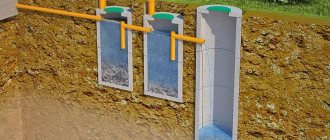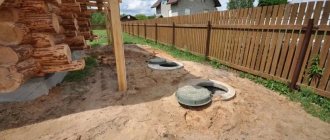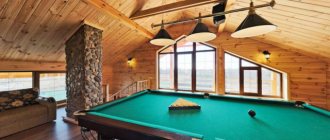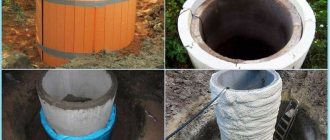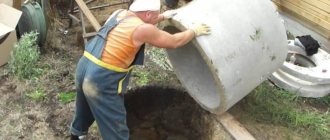The process of installing a septic tank in almost all cases implies the need to prepare a pit for the septic tank. Particular attention should be paid to the location of this device, since it is a specific structure. First of all, you should remember that you need to retreat at least 5 meters from any structures on the site. And digging a pit for a septic tank next to the foundation of a house is strictly prohibited, since the soil will weaken, and this may lead to subsidence of the walls. The septic tank pit must be at least 20 meters away from sources of drinking water and open reservoirs. All these conditions are specified in sanitary standards. In addition, when choosing a place to build a septic tank, you should remember that a sewage disposal truck will have to periodically drive up to it, which means it should not be too far from the roadway.
But what about the shortcomings?
Despite the obvious advantages, septic tanks made of concrete rings also have disadvantages. If installation requires an excavator, a manipulator or a crane, the cost of the work increases sharply. Such septic tanks cannot be installed if groundwater is located close to the surface of the earth. They definitely need a filtration system, which can take up a lot of space on a plot of land, especially in soils with low permeability.
If water is drained using a pump, then the septic tank needs electricity to function. A ventilation system is also needed, otherwise unpleasant odors cannot be avoided.
How to dig a hole for a septic tank?
First of all, we note that you can dig a hole either on your own (or with the help of a construction team) or with the help of specialized equipment. Each of these methods has both advantages and disadvantages. If you dig a pit for a septic tank using an excavator, the work will be completed in the shortest possible time. Often, the digging procedure along with preparatory work takes no more than an hour. Digging a septic tank with the help of a construction crew can be completed in a few hours, and in some cases (depending on the size of the pit and the characteristics of the soil) the work can take several days. We won’t talk about digging a hole solely on our own - this is a very long process, which in terms of labor costs and payment is inferior to both an excavator and a team of builders. And if we compare between these two options, then it is preferable to hire an excavator for 1 hour rather than a team of workers for several days. This will be both cheaper (machine operation is always cheaper than manual labor) and faster. In addition, the confiscated land can be immediately transported outside the site using special equipment.
The only drawback of the operation of special machines is the need for a large amount of free space, because the equipment must be located somewhere on the site and have room for maneuver. And if you require absolutely smooth walls of the pit, then you should provide the possibility of access for equipment from both sides. For workers, the lack of free space cannot be a hindrance, and they can work in almost any conditions. But, as already mentioned, the cost of their services will be higher than the cost of an excavator.
Here are a few more arguments against digging a septic tank yourself. Since the volume of work is large, and the productivity of one person is not very high, this work can take a very long time. If you entrust it to a team or construction equipment, you can have time to do a lot of other work around the house or landscaping the site, or simply go to work and get paid for your work.
Determining the dimensions of a septic tank
The sanitary standards explain in detail all the nuances of installing septic tanks and their dimensions.
The depth of the septic tank varies from 1.2 m to 2.5 m. The number of people, daily inflow, characteristics of plumbing equipment and its quantity must be taken into account. Many people think that the more chambers a septic tank has, the better the cleaning will be. But in fact, the volume of the septic tank and the length of the route of movement of the wastewater are important. To improve cleaning performance, it is preferable to use large-diameter concrete rings.
Moving a septic tank to a new location
There are situations when the entire septic tank needs to be moved to a new location, for example, if sanitary requirements were not initially met. In particular, proximity to water sources was not taken into account. And this is very important! In this case, there are a number of key principles to remember that need to be followed. Firstly, in no case should you move the septic tank less than five meters, otherwise you will end up in an area of soft soil, which can be difficult. Of course, you can reinforce the walls, but why waste both money and time. The septic tank is removed manually or with the help of workers.
But it is undesirable to use technology, because it can damage the structure in a wave.
It is important to clean the septic tank before transferring. And in its entirety. Without leaving any savings in it. Then, from the middle of this structure, its excavation begins, and you can navigate along the septic tank pipe. When the level where the septic tank lies has been reached, it is cleaned first in the center, and then along the edges. Then the septic tank is disconnected and taken out. A new hole is dug, and the excavated soil is used to fill the old one. Next, the old pit is properly compacted. Four people (usually enough) then move the septic tank to a new location, and there its installation follows the traditional pattern.
Placement and installation of a septic tank
Different regulations have different requirements for the placement of septic tanks, but there are general rules. The septic tank should be 5 meters from the house and at least 1 meter from the neighboring plot, the filter well should be at a distance of 8 meters from the house. There should be 15 - 30 m to the source of water supply. It is necessary to take into account the location of the gas pipeline and the topography of the site.
A septic tank made of concrete rings must have a waterproof bottom. The joints between the rings are filled with cement or mastics. The factory neck with a manhole cover is installed at the top of the septic tank.
When installing a septic tank, you definitely need tees with vertical pipes on the pipelines. They transfer wastewater to the correct depth and retain silt from the surface of the water. A ventilation pipe is installed between the chambers of the septic tank.
If a pump is needed to move wastewater, it is placed in a special well, installed on the bottom or suspended on a chain
Features of digging a septic tank at different groundwater levels
Before you take up a shovel (invite builders or hire equipment), you should carefully study such an issue as the level of water on the site. The depth of the pit for the septic tank should be such as to be able to place it at a level of 1-1.5 meters below the surface of the earth. But in the case when groundwater is located high, it can create certain difficulties and become an obstacle to excavation work, since water will constantly accumulate in the pit
One solution to the problem may be to carry out excavation work in winter, when the groundwater level drops. But then it will be very difficult to do without special equipment. In the case when the groundwater level is normal, you can install a septic tank in the summer. If you plan to install a septic tank in an area with high groundwater level, then it is better to use factory-made structures. Such septic tanks have stiffening ribs that prevent soil and groundwater pressure from damaging the structure.
VehoPuts - wastewater treatment plant 10 Price: 879025.00 RUB
Wastewater treatment plant EvoStok Bio3 eco S Price: 78500.00 RUB
Wastewater treatment plant EvoStok Bio5 S Price: 120000.00 RUB
How much will a septic tank cost?
For example, a septic tank with two rings and a turnkey lid will cost you only 12,100 rubles, and a septic tank with 4 rings with one shaft will cost you 20,700 rubles. You can find prices and a price list for reinforced concrete septic tanks with work on our website master-well.rf. We guarantee that you will receive a high-quality septic tank that will serve you for many years. We work without intermediaries with a signed contract, and we also provide guarantees for all work performed. Call and order digging and installation of a septic tank from a reliable company with more than 10 years of experience in the Moscow region.
Works with concrete
At the next stage of building a septic tank in a country house without pumping with your own hands, you need to fill the space between the wall of the pit and the formwork with concrete mortar.
construction of a concrete cesspool without the need for pumping
To prepare the solution you need to have:
- cement M300 or 400 - one part is required;
- sifted sand - two parts will be enough;
- fine crushed stone - you also need two parts.
To mix concrete, you can use a special trough and a hoe with a hole or a concrete mixer. You need to choose a method for mixing concrete depending on what method of pouring it will be used, namely in parts or one-time for the entire height.
What should you pay attention to? The method of pouring concrete in parts has a number of advantages, despite the fact that it is quite a troublesome task. It is not necessary to use a concrete mixer, since a small amount of concrete can be mixed in the trough yourself
For convenience, you can use collapsible formwork, and the work will be performed as follows: after the first layer of concrete has dried, the formwork is rearranged. The same manipulations can be carried out with plastic tubes used as sleeves for drainage holes.
To increase the reliability of the septic tank, concrete reinforcement can be done in advance. As a rule, reinforced concrete in its strength characteristics is many times better than a conventional concrete structure, but despite this, its weight is greater.
The advantages of reinforced concrete also include the fact that you won’t have to repair the septic tank as often, and maybe no repairs will be needed at all.
To reinforce the walls and partitions of a structure, you can use any metal products, these can be corners, rods or channels. In other words, you can use various metal objects, even old bed frames and pipes.
Ideally, it is better to use reinforcing bars or welded mesh made from the same bars.
According to the rules, reinforcement must be installed between the walls of the pit and the formwork before the concrete is poured.
So, the work is carried out in this order:
- When the pit is prepared, the formwork and reinforcement are installed, the concrete solution can be poured. In order to save concrete or if there is a shortage of reinforcement, crushed stone can be laid between the pit wall and the formwork;
- After the concrete layer has dried, the formwork should be removed and moved to other walls. You also need to remove pieces of plastic pipe from the dried concrete for drainage. If large sheets of material are used as formwork, then within a week the septic tank body will be ready;
- When the walls of the future septic tank are fully prepared, you can safely install the partition. If there is a need to save money, you can use non-new bricks. The height of such a partition should not reach the very top of the septic tank.
Construction of a brick septic tank
To build a septic tank without the need for pumping, you can use clinker bricks, and the shape of the structure can be round or rectangular. To improve the waterproofing properties of the septic tank, it is recommended to treat the external walls with mastic and fill the gap with clay. As for the internal walls, it is better to coat them with cement mortar, and simply concrete the bottom. This must be done to prevent dirty waste from going into the ground.
It is recommended to pour sand and crushed stone at the bottom of the last compartment, while it is advisable to lay out the walls with small gaps. This way, excess filtered water can easily pass into the ground. It is advisable to use tees to connect tanks to each other.
Construction of a monolithic concrete structure
To ensure sufficient tightness of such a septic tank, its base must be poured with concrete on top of a layer of sand. When the solution has completely hardened, you can begin installing the formwork and pouring concrete into the walls.
During the work, we must not forget about the arrangement of overflows between the compartments. Regular tees for sewer pipes are quite suitable for this.
construction of a concrete septic tank with an overflow system and a drainage system
The upper part of the septic tank will also need to be filled with solution, and it is important to leave special openings that can be closed with hatches. Drainage can be improved by digging into the bottom of the last compartment of the tube, only in this case the bottom is not filled with concrete, but simply sprinkled with crushed stone
Drainage can be improved by digging a tube into the bottom of the last compartment, only in this case the bottom is not filled with concrete, but simply sprinkled with crushed stone.
Cast
- Dwayne Johnson as Luke Hobbs
- Jason Statham as Deckard Shaw
Joshua Coombes as Young Deckard Shaw - Idris Elba as Brixton Lore
- Vanessa Kirby as Hattie Shaw
Meesha Garbett as Young Hattie Shaw - Eiza Gonzalez as Margarita (aka Madame M)
- Helen Mirren as Magdalene "Queenie" Shaw
- Eliana Sua as Samantha Hobbs
- Roman Reigns as Mateo Hobbs
- Cliff Curtis as Jonah Hobbs
- Eddie Marsan as Professor Andreiko
- Josh Mauga as Timo Hobbs
- John Tui as Kal Hobbs
- Lori Pelenise Tuisano as Sefina Hobbs
- Rob Delaney as Loeb
- Ryan Reynolds as Victor Locke
- Kevin Hart as Dinkley
- Harry Hickles as Young Owen Shaw
- Alex King as Lt. Grapefruit
- Tom Wu as Tsoi
- John Macdonald as Lermotov
Why choose Septic Topas Plus products
Many companies offer the sale of equipment and installation of local sewage systems, and the company Septic Topas Plus is successfully engaged in this in the Moscow and Moscow region markets. We offer our clients exclusively high-quality waste disposal units - the best-selling and best models Topas, Unilos Astra, Eurolos, Termit, Tver, Diamant, Ergobox, Dochista, Terra, Biozon and Kolovesi. Each septic tank comes with a 3-year warranty, all devices are certified, and their price fully corresponds to the quality. A flexible system of discounts has been developed for regular customers, and there is an affiliate program.
Creating a filtration well
A filter well can only be installed on a soil base that allows and absorbs water well. If sand, crushed stone or gravel-pebble deposits lie under its conditional bottom, then the disposal of treated wastewater into the underlying soil layers will occur without the slightest obstacle.
The 1 m absorption well is backfilled with a soil filter so that the backfill fractions decrease with height. First, the bottom is filled with sand - the thickness of the sand layer should be 30-40 cm, then a layer of fine gravel is formed - 30-40 cm.
The upper tier of the soil filter is usually larger crushed stone or gravel, which is covered with a layer of 20-30 cm.
To build the walls of a well with bottom and side filtration, perforated rings are used, the diameter of the holes is about 30-50 mm
If wastewater is to be disposed of not only through the bottom, but also through the walls, the lower ring of the drainage well must be perforated. It is installed using the same technology as rings with solid walls. The voids between the walls of the pit and the concrete rings are filled with crushed stone.
If a filtration field is to be constructed, perforated pipes will be used. They are laid on a gravel-sand “cushion”, which ensures the infiltration of treated wastewater into the underlying soil layers, and the top is covered with geotextiles and covered with earth.
Formwork and concrete
Formwork
And finally, the pit is ready, the walls are leveled, we make the formwork. To be cheap, we collect old boards from anything and use nails, a saw and a hammer to assemble a layer of formwork.
Sequence of concreting work.
- Please note that you will then have to raise the formwork after the next layer of concrete has set. It is advisable not to exceed 50 cm in height at a time, otherwise the likelihood of poor concrete filling into the formwork increases, voids are formed and quality decreases.
- Do not forget to reinforce each layer with iron wire and butt it with stones.
- Start each subsequent layer of concrete the next day. In the morning, raise the formwork for the next layer.
- Of course, if you have a vibrator for pouring concrete, then you can go higher at a time. But as you pour the solution, you must carefully walk around the perimeter of the pour with a vibrator.
- Use smaller gravel. For thin septic tank walls, large gravel reduces their strength.
- The wall divides the pit into two chambers. A pipe containing wastewater enters the first chamber. The second chamber is intended to be two times smaller than the first. For example: if the size of the first chamber is 2 by 2 m, the second chamber should be about 2 by 1 m in size.
- We build double-sided formwork along the line of the dividing wall. While pouring concrete into this wall, insert a plastic or cast iron tee in the same manner as shown in the figure. Diameter of at least 100 mm.
- Don't forget to insert the inlet drain pipe into the wall. The pipe must enter the septic tank through a wooden box so that thermal expansion does not break the pipe.
- The installation level of the tee is selected so that the upper edge of the tee in the first chamber is slightly lower than the lower edge of the drain pipe.
The layer-by-layer method of pouring concrete allows you to make the concrete denser, without air bubbles, save materials and make the entire structure more durable in the end.
Since the service life is long, try to make it thick but secure. And to save the solution, put more stone.
You can save a little more on concrete. Make the partition 2-3 cm lower than the lower edge of the inlet drain pipe.
Place two sheets of corrugated slate on the partition to create holes, and place a piece of iron on top to support the ceiling. Concrete will go higher again.
Supertrough
It is very convenient to mix concrete in a homemade trough, as in the picture, made from boards and a piece of tin.
Moreover, the process requires less physical effort and is faster than loading and unloading a concrete mixer. The authors checked this statement with a stopwatch.
It is convenient to stir the solution using a converted hoe; a hole is cut inside the blade.
If you are doing concreting in the cold season, add a tablespoon of washing powder to each bucket of water.
This solution is more frost-resistant and will add plasticity to the concrete, which will prevent cracking.
What pipes are used?
To lay a sewer system on a site, pipes made of different materials are used.
| Pipe type | Features of use |
| Cast iron | Strong and durable pipes, affordable and easy to install. Difficulties may arise when connecting joints. Cast iron corrodes over time and is heavy. The inner surface of cast iron will not be smooth, which will make it difficult to transport waste to the drainage pit |
| Asbestos-cement | They have a smooth surface, so blockages do not form. They are easily mounted using couplings, have less weight, but are fragile and can break during transportation |
| Polymer | They have high strength and low weight. Laying such sewer pipes can be done by one person. Easy to connect and seals well. Available in PVC, HDPE and polypropylene |
| Corrugated | They withstand dynamic loads well and are resistant to freezing, but can become deformed at too low temperatures. |
Experts recommend using plastic pipes for laying sewers. In this case, the diameter of their cross-section is selected based on the number of bathrooms in the house. For 2 toilets a pipe with a diameter of 110 mm is suitable; for 3 or more bathrooms you need to install a pipe with a diameter of 160 mm.
Installation of a septic tank "Unilos Astra"
This septic tank is energy-dependent, but compact, does not require frequent cleaning, and does not emit unpleasant odors. Its septic tank volume for 4 people is 2 m3. Installation will be carried out at the highest point of the site at a distance of 4 m from the exit of the sewer pipe from the house.
Septic tank "Unilos Astra"
Step 1. First of all, prepare a square pit for installation of equipment.
Digging a pit
You may be interested in information - Eurobion 5 forced reset
Step 2. Next to the pit for the septic tank itself, another pit with a circular cross-section is built for the construction of a filtration well.
Digging a pit for a filtration well
Step 3. The so-called caisson is assembled from 5*15 cm boards. It must be larger in size than the septic tank so that the equipment can fit into it.
Boards 5*15 cm
Assembling a caisson from boards
Step 4. The wide walls of the wooden structure are nailed together with 150 mm nails. In this case, the boards must be fitted very tightly to each other to avoid water seepage. The end walls are also nailed down.
The structure is almost ready
Attention! The racks on which the caisson boards rest must be free of defects and cracks.
Step 5. Cuts are made on the sides of the caisson with a chainsaw, which will help lower the caisson into the pit.
Cuts are made
This makes it more convenient to lower the structure into the pit
Step 6. The caisson is carefully lowered into the pit.
The structure is lowered into the pit
Step 7. Next, the excavation of the pit in the caisson continues. The soil should be removed evenly from under the walls of the wooden structure so that it gradually falls down under the influence of its own weight. If groundwater appears, a drainage pump is installed.
Excavation from the caisson
If necessary, use a drain pump
Advice! Hitting the wooden posts with a sledgehammer will help “help” the caisson to lower.
Using a sledgehammer
Step 8. The septic tank is carefully lowered into the prepared caisson.
Preparing for installation of a septic tank
A septic tank is being installed
Filling the septic tank with water
Filling and leveling the septic tank
The septic tank is installed level
Step 9. The gaps between the walls of the septic tank and the caisson are filled with previously removed soil.
“You can see how to properly bury a septic tank in our article”
The voids are filled with soil
Step 10. Two holes are made in the body of the septic tank using crowns, and then an inlet sewer pipe is installed in one using a cuff, and a pipe for removing purified water is installed in the other.
Hole drill bits
Hole for purified water outlet for inlet pipe
Cuff for drain pipe
The hole is cleaned
Step 11. Work is underway to install the drainage well. The pit is covered with geotextiles, then the well itself is installed, which is approximately 1/3 filled with crushed stone. The latter is also poured between the wall of the well and the wall of the pit.
Installation of a drainage well
Step 12. The well is closed with a lid into which the drain pipe is connected.
The well is closed with a lid
You may be interested in information - septic tank device operating principle
Step 13. A trench for the sewer pipe is dug from the septic tank to the house, where the pipeline itself is laid directly with a slope of about 0.02 cm per linear meter. It is necessary to pour sand under it, creating a sand cushion. The cable for the septic tank, wrapped in a corrugated pipe, is also laid there.
Slope of sewer pipes
Attention! The sand cushion must be moistened and compacted! Also, when backfilling the pipe, the soil and sand must be moistened layer by layer.
Laying a sewer pipe
Preparing entrance to the house
Entering the pipe into the house
All that remains is to turn on the septic tank and use it, taking into account all the rules for operating this equipment.
Turning on the septic tank
Video - Preparatory work
Video – Septic tank “Unilos”: operating rules
Septic tanks with volley discharge 250 l
Septic tank SBO DALOS-3
| More details | Users: up to 1-3 people Salvo discharge: 250 l. Processing volume: 0.6 m3/day Price: 89,000 rub. |
Septic tank BioDeka-5 C-800
| More details | Users: up to 5 people Salvo discharge: 250 l. Processing volume: 1 m3/day Price: 85,900 rub. |
Septic tank TOPAS-S 6 Long Pr
| More details | Users: up to 6 people Salvo discharge: 250 l. Processing volume: 1.15 m3/day Price: 169,200 rub. |
Septic tank Kolo Vesi 3
| More details | Users: up to 4-6 people Salvo discharge: 250 l. Processing volume: 0.6 m3/day Price: 155,900 rub. |
Septic tank Topas 6
| More details | Users: up to 6 people Salvo discharge: 250 l. Processing volume: 1.15 m3/day Price: 149,900 rub. |
Septic tank Astra 5
| More details | Users: up to 5 people Salvo discharge: 250 l. Processing volume: 1 m3/day Price: 94,000 rub. |
You are getting:
- Free shipping
- Installation in 1 day
- 2 year warranty
Order by phone: 8
Telephone
Important Tips
- It is best to make ventilation from asbestos-cement pipes (sizes, price) or polyvinyl chloride. If this is a problem for you, make your own wooden gutter. Impregnate the inside of the boards with grease and paint the outside in a bright color. Install a galvanized sheet umbrella on top of the structure.
- To prevent soil from being sucked in during pumping, make a hole in the pipe intended for this purpose, 15-20 cm away from the edge of the pipe.
- If necessary, you can modify the product for ventilation and use it to pump out wastewater (in rare cases, but this may be necessary).
Regulatory documents governing the installation of sewerage in a private house
There is a “Code of Rules: Internal Plumbing and Sewage of Buildings,” which brings together the entire regulatory framework for the planning, installation and operation of private sewerage. With all the latest changes and additions, the code was put into effect on January 1, 2013. This standard was developed by the scientific and scientific institute OJSC SantekhNIIproekt.
The “Code of Rules” is built on the following documents relating to sewer systems:
- SNiP 2.01.09-85 “Sewerage. External networks and structures."
- SNiP 2.04.01-85 “Internal water supply and sewerage of buildings: updated edition.”
- SNiP 3.05.01-85 “Internal sanitary systems of buildings.”
- SNiP 2.01.09-91 “Buildings and structures in undermined areas and subsidence soils.”
- GOST 17.01.2.03-90 “Nature conservation. Hydrosphere. Criteria and indicators of water quality for irrigation.”
- SanPiN 2.1.2645-01 “Sanitary and epidemiological requirements for living conditions in residential buildings and premises.”
Based on the above regulatory materials, each owner of a private house has the right to design and build a device for drainage according to an individual project.
It is worth clarifying that when applying the Code: Internal Plumbing and Sewerage of Buildings, all the rules established in it are mandatory. Selective adherence to the requirements given in the document is not permitted.
